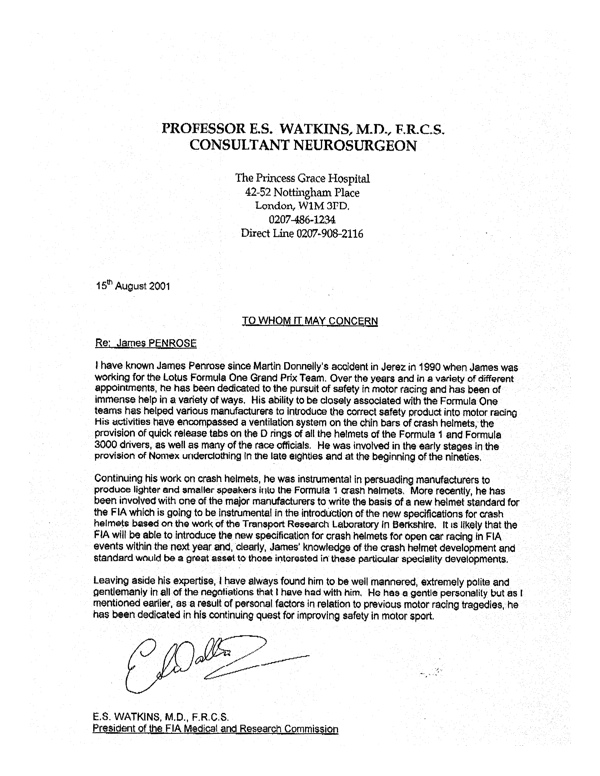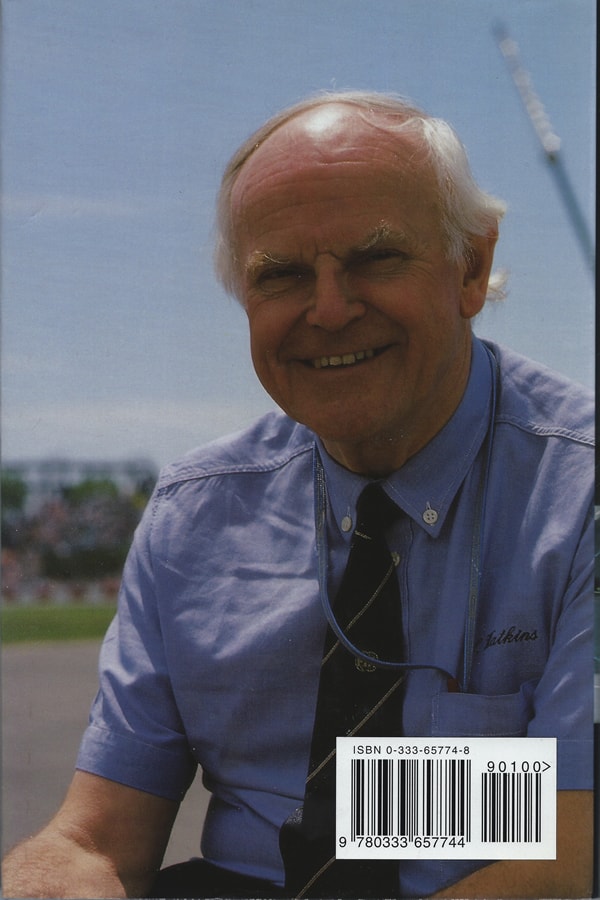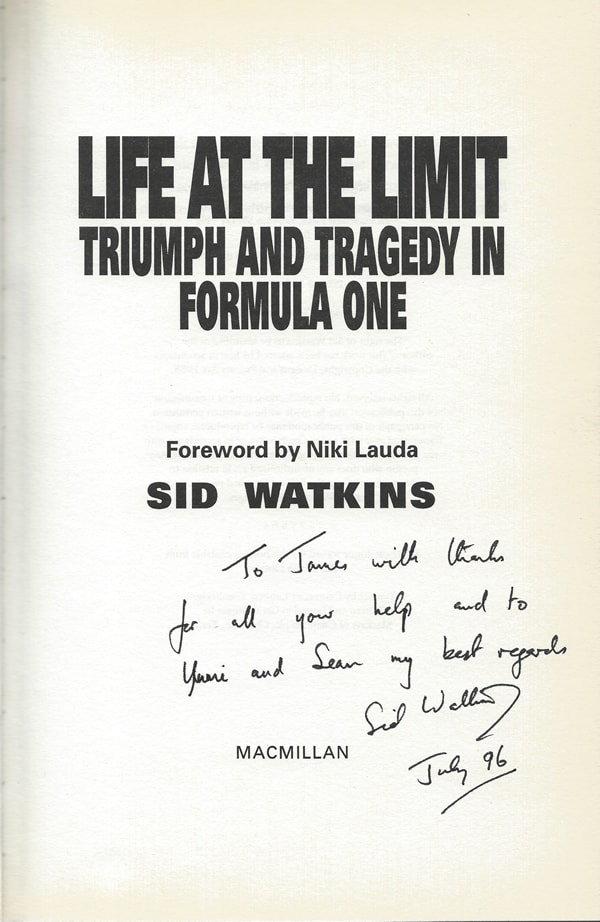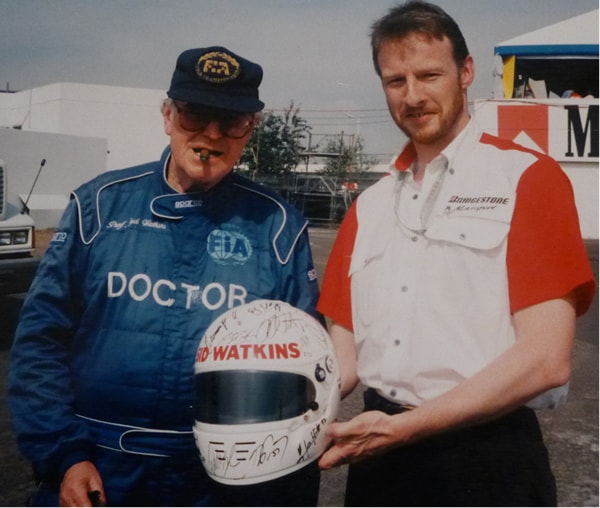
Photos

How to describe a friend like Sid? I’d been out of F1 for some years and came back in the late 1980’s at Team Lotus. By pure chance I ended up looking after the driver safety gear and Sid grabbed me and made me a part of his safety gang.


1997 – I’d gone to Bridgestone that year, as usual Sid roped me in to use any spare time I had and I ended up making him a new helmet and getting his old one signed by all the drivers so he could auction it off for charity!
(Photo Nicholas Duquesne)
Article
Where do you start with someone like Sid. He was a very unusual doctor.
From the age of ‘James Robertson-Justice’ doctor characters where the doctor TELLS you what he will do to you (you, the patient, have no say in the matter)… Sid was different from the establishment. Don’t misunderstand me, Sid was no roll-over, ask Rubens Barrichello about his err ‘conversations’ with Sid in 2003 if you don’t believe me!
He was a racing enthusiast and somehow got involved from the 1970’s where he worked in a hospital in America and helped as a doc at the local races.
Bernie noticed him, realised he could be of use and using Sid’s enthusiasm negotiated a fee that only an enthusiast would accept. Sid was hooked and never looked back, except to regal the tale of that ‘fee’ often.
Sid did much the same to me and I got hooked on the safety work. Lucrative – forget it, barely covered the most basic expenses and grotty hotel rooms. But it says much for Sid that I didn’t give up despite almost no reward. I wouldn’t have done it for anyone else.
No idea precisely when I first met Sid but it must have been in the late 1980’s when I was at Team Lotus. It was only because we had Satoru Nakajima driving at Team Lotus, initially teammate to Ayrton Senna and then to Nelson Piquet, that I ended up being trained by his helmet supplier, Arai Helmet Ltd. of Japan, to make and service helmets. From that point I started my involvement with safety work.
Elsewhere you can read about the chinstrap D-ring release tab. Foolishly I showed Sid what I had found in Japan and that resulted in me getting up earlier than anyone else in the team in order to be in the track early and have a good hour going round extrication teams around the track with Sid teaching helmet removal and safe extraction from a car (which I learned from Sid). That was at every Grand Prix so my sleep was curtailed severely as the other end of the day I nearly always had to attend sponsor functions late into the night.
Again elsewhere you can read about what Sid always called the F1 Super Helmet – now called the FIA 8860 – 2004 and 8860 – 2010 helmet standard. It started in 1990 with Martin Donnelly’s catastrophic accident at the Spanish Grand Prix at Jerez.
F1 has long had ‘fence sitters’ in decision making positions (and I’m not talking about Bernie in any way at all when I say that – just to be clear!) – these people wait and wait and do nothing despite overwhelming evidence that something needs to be improved. The helmet we used in F1 at that time was a case in point – essentially it was only 2 years development forward from a basic motorcycle helmet with Nomex fireproof interior. Nothing wrong in essence with that but a racing car had drivers in different position to a bike rider, racing helmets generally need radios and drink systems fitting in them, aerodynamics are different too.
When Martin Donnelly had his accident we had very clear evidence that we needed a better helmet. I worked on the specs and wrote a new standard (with a lot of help from others), but Martin was a new F1 driver, in a car that was clearly rubbish and so it was dismissed as a freak accident. Again the fence-sitters had won and zero happened. Sid pushed and pushed but couldn’t get them to budge.
Fast forward four years and Team Lotus had essentially collapsed, I had left F1 and was working with Nissan on its Le Mans, Touring Car and Rally programmes. Not inspired I wanted to get back into F1. Imola ’94 happened and two drivers died, one a multiple World Champion – maybe, just maybe this might get the fence-sitters off the fence. So Sid pushed again.
I updated the helmet standard, spec and at Hockenheim the next year a meeting took place and finally it started.
I was back in F1, with Arai this time, and working more and more with Sid. At the same time I had married a couple of years before and had a child to look after, born 3 days after that awful day in Imola in 1994. Before and after our son was born my wife at the time, Yumi, went through some pretty awful medical situations and yes – Sid was always there. In fact when she had first come to Europe from Japan to work in F1 for Ron Dennis and John Barnard at McLaren at the dawn of the first McLaren Honda programme – it was Sid who took the time to be a kind of ‘godfather’ to her (long before I even met her).
So Sid wasn’t just the drivers doctor, he was doc to everyone in the F1 paddock and their families too.
The safety work as I said was not very lucrative and eventually I gave in to an offer from Bridgestone to go back to marketing work in 1997. It was totally against what I wanted to do, but I simply could not even pay the rent on my earnings from the helmet work. Needless to say whenever a decision is made to do a job for money rather than a job you really want to do, it was an unmitigated disaster. I found myself in an office full of bitter office politics and got well and truly stabbed in the back by someone who wanted my job. I left, couldn’t find a job in F1 and ended up door to door selling telephone and electricity and gas services (also doing some airbrush painting till my sinuses said Stop).
But I kept up doing helmet consultancy work for Arai and private clients and kept a good contact with Sid.
A couple of years on and I landed a job with Interpublic (at the time they bought Brands Hatch and were big into motorsports), this gave me three years normal financial situation once more and even some spare time so Sid got me working quietly in the background on the HANS. More or less I was just assessing where it was at, rather than direct involvement as that work had been farmed out to TRL.
For many years Sid gave a lecture at the Autosports International Exhibition at the NEC. 2003 was no exception and I went solely to go to Sid’s lecture. Two years the HANS had been in F1 cars testing and for two years the teams and drivers complained incessantly about discomfort and frankly it being impossible to drive competitively with the HANS on. Sid was sounding me out, without saying what he had in mind. F1 had given up, but Sid had not.
A few days later I got a call from him, followed by another from Ian Brown in the FIA Safety Department in Geneva and I was given the responsibility of making it work or not. If I could do it, it would be mandatory, if not it would be history, over to me. You can read elsewhere more fully about that.
Those are a few milestones in the history of my time working with Sid either openly within the FIA or behind the scenes ‘covertly’, if that’s the right word for it, working for him.
Perhaps the times best remembered will be the relaxed evenings after a Grand Prix where the tent outside Bernie’s motorhome became almost ‘Sid’s enclave’. A gang descended on the Karl-Heinz Zimmermann run motorhome and got stuck into red wine and exaggerated tales of derring-doo.
There was always an Austrian element to these gatherings, Niki Lauda, Gerhard Berger, Horst Röger plus honorary Austrians Agnes Carlier, Jeff Hutchinson, Mike Negline, Ayrton Senna, Michael Schumacher and of course Bernie, probably many others as well. But Sid was always at the centre, puffing his cigar and enjoying red wine after another GP was finished. The ritual still continues but we’ve lost Sid and there is rarely a GP when his laugh doesn’t surface in my mind at one stage or other. Damn it I miss him still, and the red wine!